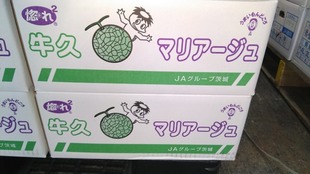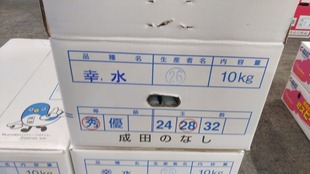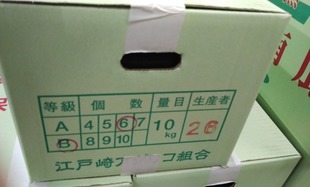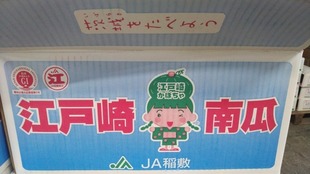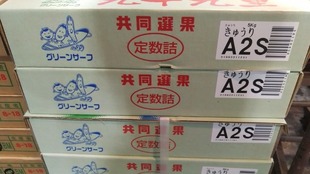The EXCELLENT SWIMMER Monument is located in a part of Ushiku City, about 300 meters south of the Iris Garden. It's a very difficult place to find, but there are signs everywhere, so we were able to get there by car without any trouble. The area is close to Ushiku Swamp, but the swamp cannot be seen from the location of the water demon monument, and its lonely appearance surrounded by greenery is an impressive sight. Why not visit it over the holidays?
【Product name】
Ushiku Marriage Melon
Cucumis melo L.
KamiOta Town, Ushiku City, Ibaraki Prefecture (JA Suigo Tsukuba, JA Group Ibaraki)
【Origin of name】
In Japan, it means the compatibility of food. Cela signifie "Mariage, conjugality, combinaison". Does it mean that eating is really radiant?
In mid-April 2022, shipments of Ushiku's brand agricultural product "Ushiku Kappa Radish" began. At the "Matching Party" held at the Ushiku Agricultural Economic Center in JA Suigo Tsukuba on April 11, the producers carefully checked whether the shape and color gloss were in line with the freshly washed white japanese white radish. It seems that he has decided. Cultivation of Japanese radish in the city began in 1986, and since 1992 it has been nicknamed "Ushiku Kappa Daikon". The JA radish production subcommittee (34 members) seems to be planting about 20 hectares of spring radish and about 40 hectares of autumn / winter radish. The spring radish is perfect for salads because it has a nice color and is fresh. In 2005, it seems that Japanese white radish was the first radish in the prefecture to be designated as a brand promotion production area in the prefecture. We have created a control standard unique to the subcommittee that reduces the amount of pesticides used, and cultivate safe and secure radish that is particular about the flavor and texture suitable for raw food. In February 2022, the radish production subcommittee established a youth division consisting of 16 young producers in their 20s and 40s, including new farmers. Wide area agricultural cooperative spanning 4 cities(Tsuchiura, Ryugasaki, Ushiku, Kasumigaura), 2 towns(Ami, Tone)and 1 village(Miho). Located in the southern part of Ibaraki Prefecture. Mt. Tsukuba to the north and Kasumigaura to the east, Ushiku Swamp to the west and Tone River to the south. A historic area blessed with water and greenery. Within 45-70 km from Tokyo. The coast of Kasumigaura is a major production area for one of the specialty products(JA), “lotus root”. In addition, it boasts the highest production volume in Japan and is famous. Three large rivers(利根川 / 小貝川 / 桜川)flow through the jurisdiction, rice cultivation is flourishing in the paddy fields of the basin. Agricultural products of fruits and vegetables and flowers that make use of fertile soil are also actively produced. “Tsuchiura City, Ibaraki Prefecture”, Villages have been born and daily lives have been carried out on the rich land brought about by water and greenery. From ancient times, it seems that it has been a rich land blessed with seafood and mountain food. Ruins have been discovered that indicate that people have already lived since the Paleolithic era over 14,000 years ago. More than 50 plateaus such as Mt. Mari, Hitana, Kidamari, Tamura, Okijuku district. In the Jyomon era, Kasumigaura turned into a cove connected to the sea. The invention of earthenware will allow people to cook and store food. Kamitakatsu Kaizuka site(Designated as a national historic site in 1977): Ruins of the late Jomon period 4,000 to 3,000 years ago. The remains of a village where people lived by collecting abundant fish and shellfish, salt, and surrounding animals and plants. Opened on October 17, 1995 as a registered museum “Kamitakatsu-kaizuka Hometown History Square”. It consists of Kamikotsu Kaizuka (4.4 ha), a nationally designated historic site, and the adjacent Archaeological Museum (0.5 ha). In the Yayoi period, rice cultivation using Yatsu began in Tsuchiura. Villages have been found in Kidamari, Shishitsuka, Nagakuni, etc. The large-scale settlement traces found in the Harada archaeological site of Murasakigaoka are one of the largest in the prefecture in the latter half of the Yayoi period. During the Kofun period, the number of archaeological sites found on the plateau increased, and it is believed that the population of the area increased further. Large-scale settlement traces have also been found in Kidaamaridai and Hitanadai. Kisakizuka tumulus, Ozuka tumulus, Mushazuka tumulus, etc. They are jars with baskets on the plateau overlooking Kasumigaura and Sakuragawa. Around this time, Tsuchiura also had a powerful family with the power to join hands with the Yamato administration(From the viewpoint of the formation of the ancient state of Japan, the Miwa Regime can be thought to be the first Yamato Administration.). In the Nara and Heian era, a legal system called Ritsuryo(Centralized government) was established following the Tang Dynasty in China. The whole country is divided into administrative units such as roads, countries, counties, and villages (later townships). Farmers were provided with paddy fields in a fixed area, but instead imposed tax and military service obligations. Hitachi at that time consisted of 11 districts, and the city areas were Ibaraki, Tsukuba, Kawachi, and Shida. The ancient villages that were run by the Tamura and Okijuku site group and the Mt. Karasu ruins are the remains of a powerful settlement during this period. Also, the time when a new culture represented by Buddhism began to spread to rural areas. When the system of decree that started(laws and ordinance system)in the Nara period loosened and the authority of the government was lost, the land was dominated by powerful ones. Armed to protect their land and property, samurai emerged. During the medieval period of Kamakura, the Northern and Southern Dynasties, Muromachi, and the Warring States period, samurai came to power. The samurai, who were only vassals of the aristocrats, gradually overwhelmed the aristocrats who were their masters. Mr. Oda was one of the samurai who was active throughout the Middle Ages in the southern part of Hitachi Province. During the Kamakura period, he extended his power on behalf of Mr. Daijyo. During the Northern and Southern Dynasties(Nanboku-cho period, Northern and Southern dynasties, Southern and Northern Dynasties (Vietnam)), it became the core of the Southern Court of Hitachi Province. In the Warring States period, he gradually lost his territory in the conflict with Mr. Satake in the north. During the Tensho era, he went down to the army gate and lost his territory. The Middle Ages was also a period of war, and people believed in Buddhism because of social unrest, and Buddhism dominated the culture. Even in tsuchiura, Buddhism prospered under the protection of Mr. Oda and Mr. Suganoya, a subordinate person. Remnants still remain in Daishoji-Temple and Hannyaji-Temple. It was in the Middle Ages that place names first appeared in historical materials. Tsuchiura and its surrounding area at that time: It was included in the villa of Toji(Hyakugo Monjyo-24067)によって, 3か条が知られる. Although the accurate provisions are unknown, three Articles are known from the ancient documents handed down in Toji Temple (“Toji Hyakugo Monjyo” 100 case documents of the Toji Temple). It's collection of ancient documents includes the 'Toji Hyakugo Monjo Document,' a National Treasure, which had been handed down at Toji Temple (also known as Kyogokokuji Temple) that is associated with Kukai, a well-known Buddhist priest, in Minami Ward of Kyoto City, and 'Ancient documents and books of Kanchiin Temple' that had been handed down at Kanchiin Temple, a sub temple of Toji Temple, and 'Kawashimake Bunsho' (the Kawashima family documents), which are both designated as Important Cultural Properties-Ketsugetsujou: Kyoto) called Shintaso. Land and water transportation base where people and things come and go: For about 260 years after Ieyasu Tokugawa opened the shogunate in Edo in 1603, there was no battle with foreign countries or civil war. It is said that Mr. Tsuchiya ruled the Tsuchiura region for the longest time as a feudal lord. The second generation Masanao has served four generals since Tsunayoshi Tokugawa, and has been in office for more than 30 years. It owns 95,000 koku of rice, including excursions in the Kansai and Tohoku regions. It was also during this period that the lord of the Shogunate developed a transportation network. In 1604, the Mito Kaido connecting Edo and Mito(The roads which ran from Edo to Sendai along the Pacific coast were called 'Rikuzenhama-kaido Road,' and among them the one which ran to Mito City, where one of three privileged branches of Tokugawa family was located, was occasionally called ‘Mito-kaido Road.’)was passed through the town of Tsuchiura. A waterway that enters the Tone River via Kasumigaura and Kitaura and leads to Edo Bay is also formed. A ship loaded with annual tribute rice, soy sauce, oil, wood, etc. sails 53 ri (About 212 km) for about two nights and three days. Commerce has developed, and there are headquarters, travel baskets, wholesalers, and many merchants lined up in the town. Along with Noda and Choshi, it was famous as a soy sauce producing area. Against the background of economic affluence, the common people become the bearers of culture. Education through terakoya(A temple school)has become widespread, creating a climate where not only public houses and samurai but also ordinary people can enjoy culture. Minaka Irokawa or Bokusen Numajiri: Many excellent scholars and writers are active. Clan school, Ikubun building, 1799. Understructure was built and developed in the Edo period. Supported by the development of industry, it is famous as the second largest city in Hitachi after Mito. The years that have continued to develop as a commercial city are proof of people who lived in the times with dreams. From the Meiji era to the Showa era, Japan was forced to change and progress in the midst of the great trends of the world. With the Meiji Restoration, the political system has changed significantly. 1871: Haihan-chiken (the feudal domain system was abolished and the prefectural system was introduced.). Became Tsuchiura Prefecture, and became part of Niihari Prefecture due to the consolidation of prefectures. April 1, 1889: The act of the City, town, and village was carried out. The towns and villages that will shape the current Tsuchiura City are born. In 1896, the railroad opened from Tsuchiura to Tabata(Tokyo). The education system has also changed, and the school system was promulgated in 1872. The current Tsuchiura school was opened in 1873 in the town. Entering the Showa era, Japan eventually went to war. Yokaren(in the old Japanese navy, an apprentice pilots)etc. opened. Tsuchiura Town and Manabe Town merged in 1940, the year before the Pacific War began. It has always played a role as a central city in the southern part of Ibaraki prefecture. “Make rapid progress”. Adjacent to Tsukuba Scientific City. Making lotus roots that only you can make in Japan's number one production area: “Ikeshima(池島)lotus root”. It rains a lot all year round, and there is no big difference in annual precipitation even during the driest season. It is relatively warm and is blessed with abundant nature such as Kasumigaura and the greenery that connects to Mt. Tsukuba. It combines topography, meteorological conditions, the development of transportation networks, and the favorable location conditions of being close to the metropolitan area's large consumption areas. Lotus root (Ibaraki Prefecture brand production area designation): No. 1 in national production (about 500 ha acreage); Around kasumigaura, which is blessed with abundant water and low humidity, it has been cultivated for more than 50 years as Japan's number one Lotus root producing area. In recent years, large-scale greenhouses have become widespread and varieties have been improved, and a system for cultivating high-quality lotus roots is in place throughout the year. For harvesting, we use “water digging” to remove the surrounding soil with water pressure so as not to damage the lotus root and make the lotus root stand out. It is said that the natural conditions of fertile soil and high water temperature grow delicious agricultural products. When you cut it into round slices, the round cavities are lined up and you can see the other side well, so you eat with the auspices that "the future is good". If I had to choose, I receive lotus roots from the same area every year. In addition to kidney beans ('ingenmame' in Japanese), which became named after Yinyuan, moso bamboo, watermelon and lotus root are also said to have been brought to Japan by Yinyuan(Shinku Daishi Ingen (1592-1673) : Founder of Japanese Obaku Sect and was from China). ‘Imaizumi’, 土浦市遺跡調査会 1997 『土浦市今泉霊園拡張工事事業地内埋蔵文化財調査報告書 : 根鹿北遺跡 / 栗山窯跡発掘調査報告書』土浦市教育委員会, Nejika-kita Remains - 集落, 弥生時代, 竪穴住居, 土師器(後期後半), 台地上に“28軒”の竪穴住居跡が確認. 古墳時代, 竪穴住居, 古墳3, 土師器, 鉄製品, 住居内からは, 炭化物: 焼土が出土.平安時代, 竪穴住居, 掘立柱建物, 粘土採掘坑, 土坑, 土師器, 須恵器, 瓦塔, 瓦堂, 墨書土器,鉄鉢形土器, 鉄製品, 土製竈, 終末期の方墳2基: 主体部のみ1基. 台地上に, 平安時代の竪穴住居跡は, 11軒確認. 尾根上に, 4棟からなる掘立柱建物跡群が存在し, 北側の溝から瓦塔: 瓦堂が出土. 近辺の埋没谷から燈明専用の土師器小皿や,「佛」と墨書された鉄鉢形土器が出土. Kuriyama kiln site - 窯, 奈良時代,灰原,須恵器(蓋杯, 高台杯, 高杯, 円面硯など),須恵器窯跡が台地斜面に, 1基確認. 7世紀末の遺物が出土. 蓋は, 返りが明瞭に存する. 古文書 / 小田孝朝下文 - 土浦最古, 南北朝時代の1374年(応安7年)に書かれたもので, 小田家第八代城主(小田,男体)孝朝公の黒印状. “左兵衛尉孝頼”は, 右筆. この頃, 帰依を受けた「今泉寺(Konsenji Temple)」は, 永国より, 田中荘平塚(現: つくば市西平塚)に移転し, 羽黒山今泉院大聖寺と号した. 当時, 十六世祐尊が代. 一条天皇の御代, 995年(長徳元年)に, 醍醐寺, 小野曼陀羅寺(随心院; 真言宗善通寺派大本山): 小野成尊僧都(仁海僧正の付弟)により「今泉寺」として, 現在地より東約500m先の永国の中央, 亀井墓地近辺に開山されたのが, 縁起だと伝わる. “Ushiku City”, Located in the southern part of the same prefecture. It is 50 km from the capital Tokyo. It has an area of about 15 km east-west and about 10 km north-south. Area is 58.89 km2. The town system was enforced in 1954 and merged with Okada Village in the same year. Merged with Okuno Village the following year. The city system will be enforced in 1986. As a central city area in the Edo period, post-station towns of Rikuzenhama Kaido (Currently Japan National Route 6). At that time, there were 1 stronghold, 0 sub-honjin, and 15 inn. It was an important post station located almost in the center of Mito Kaido. Located on the Inashiki plateau, the eastern part is a production center for peanuts and sweet potatoes. In the western part, many vegetables such as Japanese hornwort and spinach are produced. Due to the good location to access Joban Line and Japan National Route No. 6, development of residential land is progressing as a new satellite city in the metropolitan area. It has also made great strides. 国指定文化財 : 建造物, シャトーカミヤ旧醸造場施設(3棟), オエノンホールディングス株式会社, 中央, 平成20年6月9日, 県指定文化財 : 彫刻阿弥陀如来坐像, 願名寺, 奥原町, 昭和33年3月12日, 工芸品, 太刀 銘 備前國長船住長光作, 個人, 牛久町, 昭和36年3月24日, 工芸品, 太刀 銘 大和國当麻友(以下切)伝友清, 個人, 牛久町, 昭和36年3月24日, 彫刻, 十一面観音菩薩坐像, 観音寺, 久野町, 昭和60年12月16日, 建造物, 観音寺本堂と仁王門, 観音寺, 久野町, 平成3年1月25日. 市指定文化財 : 工芸品, 東林寺城跡五輪塔, 東林寺, 新地町, 昭和49年5月1日, 工芸品, 得月院五輪塔, 得月院, 城中町, 昭和58年5月6日, 天然記念物, 榧得月院, 牛久市, 城中町, 昭和58年5月6日, 史跡, 牛久城大手門跡, 牛久市, 城中町, 昭和58年5月6日, 史跡, 女化道道標, さくら台, 昭和58年5月6日, “史跡, 大日塚及び大日如来石仏, 個人, 上太田町, 昭和58年5月6日”, 史跡, 大日塚及び大日如来石仏, 鹿嶋神社, 島田町, 昭和58年5月6日, 史跡, 大日塚及び大日如来石仏, 個人, 桂町, 昭和58年5月6日, 史跡, 中根一里塚, ひたち野西, 昭和62年4月1日, 工芸品, 薬師寺宝塔, 薬師寺, 田宮町, 昭和62年4月1日, 彫刻, 木造薬師如来坐像, 城中町行政区, 城中町, 平成11年6月23日, 史跡, 成井一里塚, 個人, 城中町, 平成13年6月22日, 史跡, 小坂城跡, 小坂町, 平成18年11月24日, 工芸品, 俳人石龍の墓碑, 正源寺, 牛久町, 平成20年9月26日, 工芸品, 金剛界大日如来石仏(時念仏塔), 薬師寺, 田宮町, 平成20年9月26日, 彫刻, 阿弥陀如来三尊像, 浄妙寺, 井ノ岡町, 平成20年9月26日, 彫刻, 閻魔大王と奪衣婆坐像, 得月院, 城中町, 平成20年9月26日, 考古資料, 姥神遺跡出土, 宝珠硯, 牛久市教育委員会, 平成22年6月28日, 建造物, 雲魚亭, 城中町, 平成22年6月28日, 工芸品, 青面金剛像, 東猯穴町行政区, 東猯穴町, 平成22年6月28日, 考古資料, ヤツノ上遺跡出土大洞A式期土偶及び土器群, 牛久市教育委員会, 平成23年10月17日, 絵画, 阿弥陀来迎及び千手観音図, 観音寺, 久野町, 平成23年10月17日, 天然記念物, 田宮山薬師寺参道, 並木薬師寺, 田宮町, 平成23年10月17日, 絵画紙本, 淡彩, 老楊と荒村, “小川芋銭筆” 牛久市, 平成24年5月21日, 絵画紙本, 淡彩, “田家四季草画”, 小川芋銭筆, 牛久市, 平成24年5月21日, 工芸品, 河童の碑, 個人, 城中町, 平成25年4月22日, 歴史資料, 牛久藩大名行列図巻, 牛久市教育委員会, 平成30年3月26日. 国登録有形文化財(建造物): 旧岡田小学校女化分校校舎, 女化町, 平成29年5月10日. 記録作成等の措置を講ずべき無形文化財(国選択): 風俗慣習関係, 東関東の盆綱, 茨城県, 千葉県, 平成27年3月2日.“牛久河童(小川芋銭(茂吉; 1868-1938)氏, 妻 コウ 氏: 長塚節 氏, 山村暮鳥 氏, 野口雨情 氏)西瓜”, It has been branded since 2000 and giant (Ball) watermelon is designated as a prefecture brand promotion area (銘柄推進産地: 沖積低地と関東ロームから成る洪積台地 (旧郡: 稲敷台地) の二層構造: Kanto Plain). The committee has created its own pest control standards that reduce the amount of pesticide used, and is working to ensure thorough entry. Basically, agricultural chemicals (in this document, “Agricultural Chemicals” refers to agricultural chemicals, feed additives, and veterinary drugs) which are used in and outside Japan are evaluated from various aspects, including toxicity, prior to the authorization of their use. Based on these evaluations, restrictions are set on use amounts and target crops on which they are permitted for use. Also, ways of use and residue standards for foods are established. The uniform limit is applied to agricultural chemicals for which residue standards are not established (Ministry of Health, Labor and Welfare (Japan)).「持続性の高い農業生産方式の導入の促進に関する法律(平成11年7月28日: 法律第110号)」: A farmer certified by the prefectural governor as a practitioner of environmentally friendly agriculture. I have already explained the eco-farmer many times, so it's important to omit it. See the rare agricultural products of Ushiku, filled with the efforts and love of the producers, with your heart and eyes (I pass by because of the custom of visiting “one's family temple” in Ryugasaki City every year). The origin of “Melon” is said to be North Africa, the Middle East and East Asia. Seeds were also excavated in Japan along with Yayoi pottery. The thing at that time was a near-progenitor species such as Oriental Melon; Cucumis melo var. makuwa. Netmelon began around 1894-1895. After that, it was successfully cultivated in a greenhouse from 1903-1904. Full-scale cultivation began in 1924 in the Enshu region of Shizuoka. This story is world-famous too. “Mariage Melon's“, A congratulatory image of a wedding party from the place where the net is beautiful with red meat. The flesh color is dark salmon pink and the sugar content is stable at around 16 degrees. The skin color is grayish green, and the net is high and beautiful. The fruit shape tends to be highly spherical. The leaves are medium in size and dark in color. It is now widely known as a high-class Home Melon. It tends to be finished in an appearance close to Earl's Melon by three-dimensional cultivation. Honey Bee mating: Investigate the cause of Apis decrease and establish countermeasures, Establishing effective mites control methods. Support for the growth of Apis in Japan and stable import method of queen bee. Expected to establish a route.In a greenhouse, honey bees are exhausted and their lifespan is short. For horticultural farmers whose management has deteriorated due to lack of Apis: Japan Finance Cooperation(農林漁業セーフティネット), There is a mechanism to accommodate working capital at low interest rates with funds. In addition, it has a beautiful appearance even when cultivated on the ground. The initial grass tends to be rather gentle. It becomes stronger after the middle term and it is easy to maintain the grass vigor until harvest. Nets occur faster and stronger than traditional varieties. Not from the vertical net - It is advisable to control the temperature and humidity higher so that they occur as a whole. The producer serves as a member of the agricultural committees of ushiku city. Reiwa From July 20, 2nd year. The term of office is July 19, 5th year of Reiwa, three years later. It supports Japanese agriculture and contributes to the region.
Mariage Melon is a red meat melon with a refreshing sweetness. With plenty of fruit juice, the lingering sweetness remains in the mouth and the dream continues. It also has a long shelf life. It is a delicious melon made by a veteran of melon making and a skilled farmer. During the cultivation period, the amount of pesticides is reduced as much as possible, and it seems that they are carefully cultivated by honeybee mating.
A fusion of "appearance" that is not inferior to Earl's melon and "ease of making" of terrestrial melon. The roots have good vitality and vines, and the quality does not deteriorate even if the number of fruits is set, and the high yield has earned a good reputation from agricultural workers. In addition, it seems to be popular because of its high sugar content, low carotene odor, and high-class appearance.
Western honey bee is said to have been first used for pear cultivation in the United States in the latter half of the 18th century. Bees have drawbacks as pollinators, such as not nesting in low temperatures and bad weather, and not visiting tomatoes, but they seem to have the advantage of being easy to manage due to the large number of individuals in each nest. In Japan, it is used for facility cultivation of strawberries and melons, and for pollination of citrus fruits. The activity temperature of honeybees seems to be between 18 ℃ and 25 ℃. When the temperature is low, such as rainy days or dim cloudy days, activity tends to slow down. When using it in the greenhouse, it seems good to keep in mind the temperature control by diligently ventilating. The center temperature of the birdhouse is always controlled at 35 ° C. When it's hot, it seems that water is stored in a birdhouse and the heat of vaporization is used to lower the temperature. When it's cold, it seems that they eat honey to move their muscles and generate heat to raise the temperature. Although it is a birdhouse, it has a high flight ability, so it seems that a place with a high ceiling without obstacles is good near the hive.

